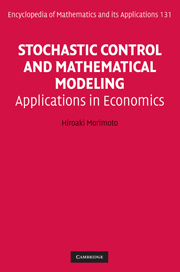Book contents
- Frontmatter
- Contents
- Preface
- Part I Stochastic Calculus and Optimal Control Theory
- Part II Applications to Mathematical Models in Economics
- 6 Production Planning and Inventory
- 7 Optimal Consumption/Investment Models
- 8 Optimal Exploitation of Renewable Resources
- 9 Optimal Consumption Models in Economic Growth
- 10 Optimal Pollution Control with Long-Run Average Criteria
- 11 Optimal Stopping Problems
- 12 Investment and Exit Decisions
- Part III Appendices
- Bibliography
- Index
7 - Optimal Consumption/Investment Models
from Part II - Applications to Mathematical Models in Economics
Published online by Cambridge University Press: 07 September 2011
- Frontmatter
- Contents
- Preface
- Part I Stochastic Calculus and Optimal Control Theory
- Part II Applications to Mathematical Models in Economics
- 6 Production Planning and Inventory
- 7 Optimal Consumption/Investment Models
- 8 Optimal Exploitation of Renewable Resources
- 9 Optimal Consumption Models in Economic Growth
- 10 Optimal Pollution Control with Long-Run Average Criteria
- 11 Optimal Stopping Problems
- 12 Investment and Exit Decisions
- Part III Appendices
- Bibliography
- Index
Summary
This chapter is concerned with the consumption and portfolio selection problems formulated by R. C. Merton [112] in mathematical finance. We consider the optimization problems to maximize the expected utility function with respect to consumption rates c(t) and portfolio processes π(t) for the vector process S(t) of prices of N risky assets S1(t), …, SN(t) and general utility functions U(c). We try to find a connection between the HJB equations and the linear differential equations by using the Legendre transform. We study the existence of the smooth solutions of the HJB equations from the point of view of viscosity solutions.
The Model
Consider the consumption and portfolio selection problem. Define the following quantities:
S0(t) = price of the riskless asset at time t.
S(t) = vector process of prices of the N risky assets S1(t), …, SN(t) at time t.
B(t) = the N-dimensional standard Brownian motion.
X(t) = total wealth at time t.
π(t) = fraction of wealth in the risky assets at time t.
r = return on the riskless asset.
b = vector of expected return on the N risky assets.
σ = volatility N × N matrix of risky assets, σ ≠ 0.
c(t) = consumption rate at time t.
U(c) = the utility function.
- Type
- Chapter
- Information
- Stochastic Control and Mathematical ModelingApplications in Economics, pp. 185 - 196Publisher: Cambridge University PressPrint publication year: 2010



